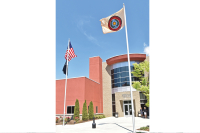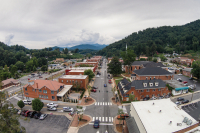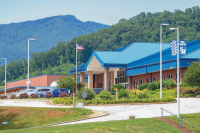Honoring the fallen: Firefighters take on 110 flights in memorial stair climb
“The first 12 are the easiest,” says Dee Massey, as he rounds the first landing of the parking deck stairwell in Waynesville.
Massey is decked out in fireman’s gear, and he and five other firefighters will spend the next 90 minutes climbing the six flights to the top, coming back down and then doing it all over again.
They are training for the 9/11 Memorial Stair Climb, a rigorous challenge to climb 110 flights in their turnout gear to honor the 343 first responders who lost their lives at the World Trade Center 10 years ago.
Massey, his son Chris and their friend Ross Escobedo will join more than 340 other firefighters for the memorial climb at various locations around the country on Sunday. They’re headed to Myrtle Beach.
Massey has been training for the event for two months, and he’s right about the first 12. Two trips up and back down the concrete stairwell is deceptively easy, even for these guys, decked out in full gear. With their full complement of equipment, it adds about 70 pounds to their body weight. On the first two rounds, they emerge onto the roof of the parking deck and start doing pushups before making the trip back down.
As time wears on, however, each round up and down gets harder and harder. The weight alone is difficult. The lion’s share of the extra bulk is in an oxygen tank pack, which provides anywhere from 15 to 35 minutes of air, depending on your size and how in shape you are.
Related Items
It’s about 40 pounds, the size of a 6-year-old, and wears like a backpack, though oddly rigid. A hip belt helps support the weight. It looks like the seatbelt from an old Buick, and after a few flights, it starts to push uncomfortably on the hips.
The real challenge, however, is the heat. Bedecked in fire clothes, the climbers’ skin struggles to breathe, making each staircase a bigger challenge. By the third round, sweat is dripping off the end of every nose. Each trip to the top is accompanied less by pushups and more by short breaks, slouched against the deck walls and soaking in the fresh air.
They’ve started the climb at 7 p.m., taking advantage of the cooler weather that dusk brings. Even in the cool of the day, the un-air-conditioned stairwell can be sweltering, and there’s a wafting stench rounding the fifth landing, which only intensifies with heat.
In this crew, some are in better shape than others. Dee and Chris Massey and Escobedo have been preparing for the event. The other three are just here for the good physical training it provides.
For firemen in rural areas such as Western North Carolina, it’s a kind of training they rarely encounter, but Dee Massey says that the last two months have made him realize that doing drills like this should be a must for everyone in his profession.
“It’s probably the hardest exercise I’ve done, and I run four or five miles every day. Stairs are a little different,” says Massey, who is a professional firefighter with the Town of Waynesville and heads up fire training at Haywood Community College.
He’s been in the business for more than 20 years, and has mostly trained for smaller buildings. Waynesville’s tallest structure is only six stories.
“I never really have trained to go up any higher, but when you start adding 60 and 100 floors to it, it makes you realize you need to be in a little better shape,” says Massey.
The others agree with him, which is why they’re here.
Ricky Mehaffey Jr. is from the Clyde firehouse, and he’s been on the job for 10 years. Too many firemen die, he says, from heart attacks, because they’re not out doing these things.
The Masseys and Escobedo are doing the stair climb to remember those killed by a horrible tragedy. Each will be running with the name and picture of a fallen firefighter from that day 10 years ago.
But training for that has made them a kind of advocate group for preventing more tragic deaths among firemen whose bodies aren’t ready for the strain and heat of the job.
“There’s an average of 100 firefighters a year die in the United States. And the biggest majority of those deaths are due to heart attacks,” says Massey. “So the only thing I can think of is to keep my heart in shape.”
And he wants other firemen to do the same. Today, fighting fire is a brotherhood, and Massey is keen to take care of his brothers.
That, he says, is what Sept. 11 gave the profession; a sense of camaraderie born of tragedy that has lasted for a decade.
“The profession has changed drastically since 9/11,” says Massey. “It’s become a bigger brotherhood.”
Where once, the ties stretched only to your firehouse, now they reach across the country. That shows even here on the parking deck roof, these six guys representing five different fire stations, seven if you count that Escobedo works for three.
The two youngest, Chris Massey and Dustin Greene, became firemen in the post-Sept. 11 era, part of a generation whose childhood was shaped by the event. Massey was 10 when the towers went down. Greene was 9.
The Myrtle Beach stair climb is part of a nation-wide series of memorial climbs, and on Sunday in cities around the country, 343 firemen and other first responders will mount 110 flights of stairs in buildings from Atlanta to San Diego. Some will be in full gear, some won’t. Some will climb all 110 flights, and others will do a fraction of that, to honor their brotherhood, and remember those whose deaths created it.









